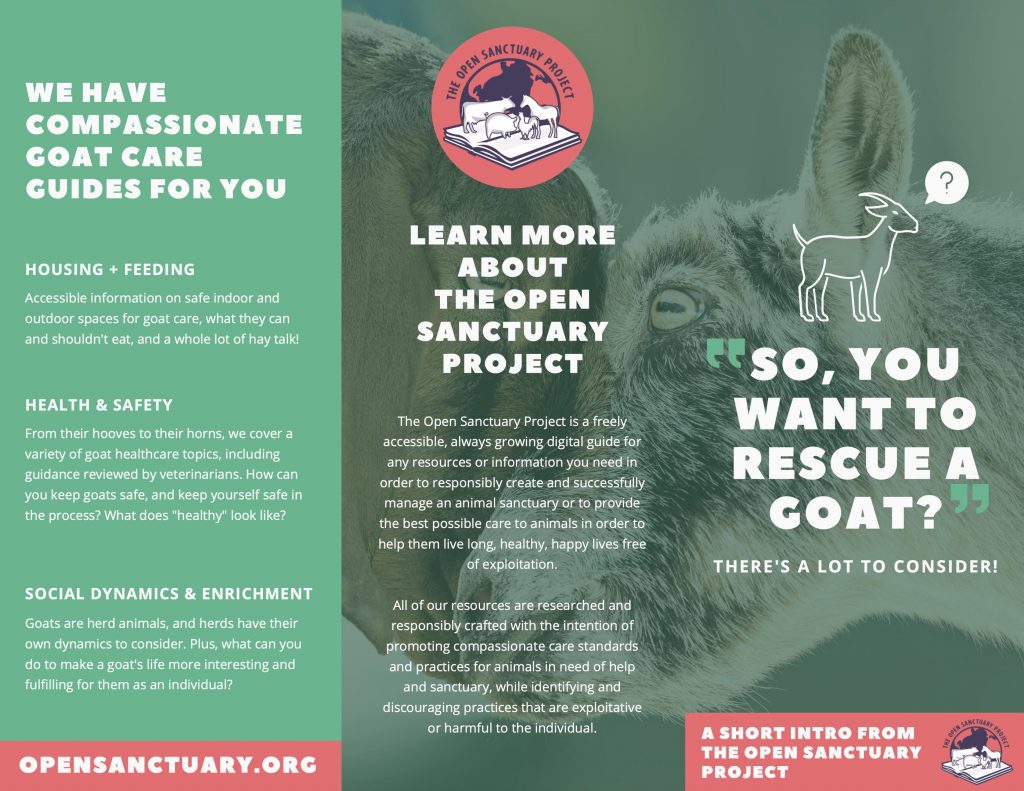

Enter either your organization’s name or your name and email below to download a free brochure PDF that you can have printed out for visitors to your organization who are interested in learning more about what it takes to provide lifelong compassionate care for a goat. Physical literature is a great way to relay a lot of information in a pleasing way to curious individuals.
Looking For More Info On This Subject?
For more information on what to consider when thinking about providing lifelong care for goats, check out our introductory resource about what goats need here!
A4 Formatted Version Of This Brochure
Edgar’s Mission created an A4 version of this brochure! If your organization operates outside of the United States, you can download a printable A4 version with the following form:
We promise not to use your email for any marketing purposes! Would you prefer to access this form in a different way? Contact us and let us know!
How’s This Literature Working For You?
Have you used this brochure at your sanctuary and want to give us your feedback on improvements? Let us know here!
Full Text Summary Of The Brochure:
Here’s The Open Sanctuary Project’s “So You Want To Rescue A Goat Brochure” text summary:
Panel 1: “So you want to rescue a goat? There’s a lot to consider! A short intro from The Open Sanctuary Project”
Panel 2: “A goat is not a lawnmower! While they might enjoy spending many days munching on greens, despite popular belief, providing lifelong responsible care to goats means so much more than letting them loose in a patch of tall grass! Goats are thoughtful, inquisitive individuals, some of whom can live for close to twenty years with your help! Caring for them requires compassionate commitment
and a lot of knowledge!”
Panel 3: “When a goat comes home: A goat first entering your home or sanctuary may be facing challenges that need to be addressed for their well-being and safety, including:
Health issues or emergencies
Hoof health concerns
Internal or external parasites
Malnutrition or overfeeding symptoms
Complex behavioral challenges
Dental health challenges
Concerning herd dynamics”
Panel 4: “Caring for life: Providing responsible lifelong care for individual goats has a lot of important elements, just like for any other companion animalAn animal who spends regular time with humans in their home and life. Typically cats and dogs are considered companion animals, though many species of animals could also be companion animals.. Goats need:
Access to an experienced veterinarian
A diet appropriate for each goat
Planned, intentional supplementation
An appropriate indoor and outdoor space
Close daily observations of the herd
Regular health evaluations from you
Medical intervention when necessary
Predator safety at home
Protection from the elements
An enriching environment and activities
Learning all you can about the compassionate care for goats before
they come into your life may be critically important for their health and well-being!”
Panel 5: “We have compassionate goat care guides for you:
Housing + Feeding: Accessible information on safe indoor and outdoor spaces for goat care, what they can and shouldn’t eat, and a whole lot of hay talk!
Health & Safety: From their hooves to their horns, we cover a variety of goat healthcare topics, including guidance reviewed by veterinarians. How can you keep goats safe, and keep yourself safe in the process? What does “healthy” look like?
Social Dynamics & Enrichment: Goats are herd animals, and herds have their own dynamics to consider. Plus, what can you do to make a goat’s life more interesting and fulfilling for them as an individual?
OpenSanctuary.org”
Panel 6: “Learn more about The Open Sanctuary Project:
The Open Sanctuary Project is a freely accessible, always growing digital guide for any resources or information you need in order to responsibly create and successfully manage an animal sanctuary or to provide the best possible care to animals in order to help them live long, healthy, happy lives free of exploitationExploitation is characterized by the abuse of a position of physical, psychological, emotional, social, or economic vulnerability to obtain agreement from someone (e.g., humans and nonhuman animals) or something (e.g, land and water) that is unable to reasonably refuse an offer or demand. It is also characterized by excessive self gain at the expense of something or someone else’s labor, well-being, and/or existence..
All of our resources are researched and responsibly crafted with the intention of promoting compassionate care standards and practices for animals in need of help and sanctuary, while identifying and discouraging practices that are exploitative or harmful to the individual.”






